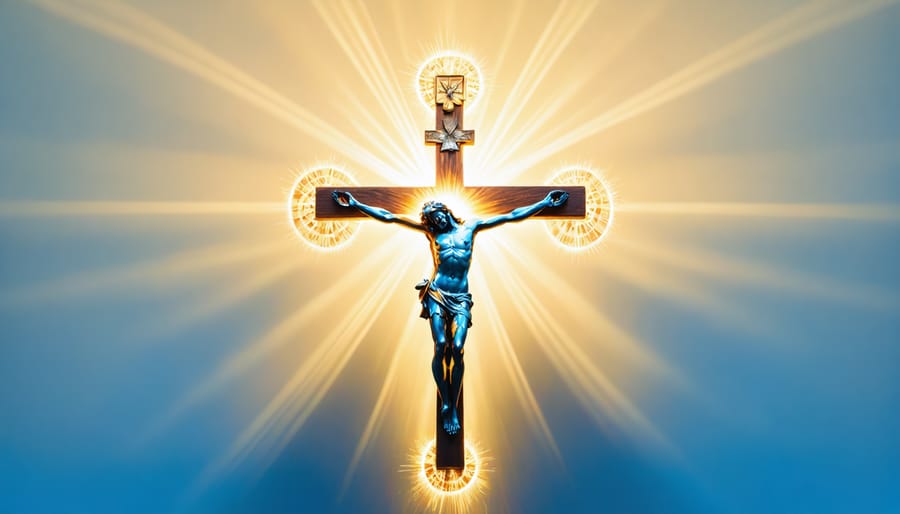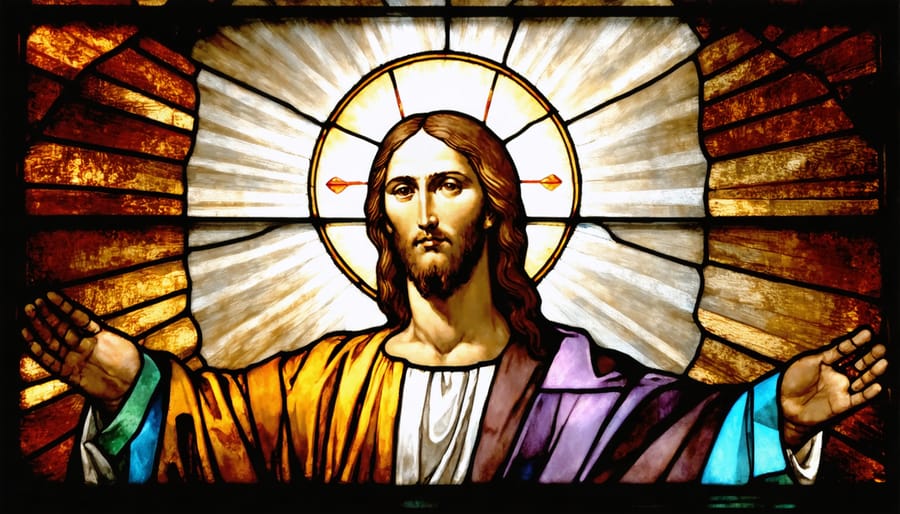Throughout the centuries, Christian art has served as a powerful visual language, conveying the profound truths and hidden meanings of the faith through a rich tapestry of symbols. These sacred emblems, woven into paintings, sculptures, and architecture, speak to the heart of Christian belief, inviting the viewer to contemplate the mysteries of God’s love and salvation. From the humble shepherd’s crook to the triumphant cross, each symbol tells a story of hope, redemption, and eternal life. In this article, we will embark on a journey through the captivating world of symbolic Christian art, exploring the significance behind these timeless images and discovering how they continue to inspire and enlighten believers to this day.
The Cross

Crucifix vs. Empty Cross
The crucifix, depicting Jesus on the cross, emphasizes His sacrifice and suffering for humanity’s sins. It serves as a powerful reminder of the price He paid for our salvation. In contrast, the empty cross symbolizes the resurrection and the triumph over death. It represents hope, new life, and the promise of eternal life through faith in Christ. While the crucifix focuses on the agony of the crucifixion, the empty cross celebrates the joy of the resurrection. Both symbols are essential to the Christian faith, highlighting different aspects of Jesus’ redemptive work and the foundation of our belief in Him.
The Power of the Cross in Art
The cross, the most recognizable symbol in Christian art, has been a powerful tool for artists to express the profound themes of salvation, sacrifice, and hope. Through various artistic mediums, from paintings and sculptures to stained glass and mosaics, the cross has been depicted in countless ways, each offering a unique perspective on its spiritual significance. Artists have often portrayed the crucifixion scene, capturing the moment of Christ’s ultimate sacrifice for humanity. These depictions serve as a reminder of the immense love and grace that flows from the cross. Other works focus on the empty cross, symbolizing the resurrection and the triumphant victory over sin and death. This imagery instills a sense of hope and assurance in the hearts of believers, reminding them of the eternal life made possible through Christ’s sacrifice. Moreover, artists have creatively incorporated the cross into abstract and symbolic pieces, inviting viewers to contemplate its deeper meanings and personal relevance. Whether adorned with intricate patterns, radiant light, or surrounded by worshiping figures, the cross in art continues to inspire and uplift, drawing people closer to the heart of the Christian faith and the transformative power of Christ’s love.
Light and Halos
In Christian art, light and halos hold deep symbolic meaning. The radiant glow surrounding holy figures represents their divinity and closeness to God. Just as Jesus proclaimed, “I am the light of the world” (John 8:12), artists use light to convey His divine nature and the illumination He brings to the souls of believers. Halos, often depicted as golden circles around the heads of saints and angels, signify their sanctity and the glory of God shining through them.
The interplay of light and shadow in religious artwork also carries profound spiritual significance. The contrast symbolizes the struggle between good and evil, the journey from darkness to light that every Christian must undertake. As believers seek to walk in the light of Christ, they experience a gradual spiritual enlightenment, shedding the shadows of sin and doubt.
Moreover, light in Christian art often represents the guiding presence of the Holy Spirit. Just as the star led the Magi to the infant Jesus, the light of God leads the faithful along the path of righteousness. In scenes of the Annunciation or Pentecost, divine light shines upon the Virgin Mary and the apostles, symbolizing the transformative power of God’s grace.
By contemplating the symbolism of light and halos in Christian art, we deepen our understanding of God’s luminous love and the radiant hope we have in Christ. As we fix our eyes on the Light of the World, we too can reflect His glory and bear witness to the eternal truths of our faith.

Colors and Their Meanings
Colors play a profound role in Christian art, each hue carrying its own symbolic significance and spiritual meaning. White, the color of purity and innocence, is often associated with the divine nature of God and the righteousness of Christ. It represents the cleansing power of faith and the promise of eternal life. Red, a color of passion and sacrifice, symbolizes the blood of Jesus shed on the cross for the redemption of humanity. It also signifies the fire of the Holy Spirit and the courage of martyrs who gave their lives for their faith.
Blue, the color of the sky and the heavens, represents the infinite nature of God and the hope of eternal life. It is also associated with the Virgin Mary, symbolizing her purity, devotion, and role as the Mother of God. Purple, a color of royalty and majesty, is often used to depict Christ as the King of Kings. It also represents the mystery of faith and the wisdom of God’s divine plan.
Gold, a precious metal that reflects light, symbolizes the glory and radiance of God. It represents the divine presence, the light of truth, and the eternal kingdom of heaven. In Christian art, gold is often used to adorn halos, crowns, and other sacred objects, emphasizing their divine nature and spiritual significance.
By understanding the deeper meanings behind these colors, believers can gain a richer appreciation for the beauty and symbolism of Christian art. As we contemplate these hues and their associations, we are reminded of the profound truths of our faith and the transformative power of God’s love in our lives.
Animals and Creatures
Through the centuries, Christian art has employed a rich tapestry of animals and mythical creatures to symbolize key theological concepts and spiritual truths. One of the most prevalent symbols is the lamb, which represents Jesus Christ, the “Lamb of God” (John 1:29). The lamb embodies purity, innocence, and the ultimate sacrifice made for the sins of humanity. In many depictions, the lamb is portrayed with a halo or a victory banner, signifying Christ’s triumph over death.
Another significant creature in Christian symbolism is the dove, which often represents the Holy Spirit. In the Gospel accounts of Jesus’ baptism, the Holy Spirit descends upon Him in the form of a dove (Matthew 3:16). The dove also symbolizes peace, hope, and new beginnings, as in the story of Noah’s ark (Genesis 8:11).
The lion, known for its strength and majesty, is frequently used to depict Christ as the “Lion of Judah” (Revelation 5:5). This image emphasizes Jesus’ power, authority, and His role as the King of kings. Conversely, lions can also represent the devil, prowling about like a roaring lion seeking those he may devour (1 Peter 5:8).
In addition to earthly creatures, Christian art features heavenly beings such as angels. These divine messengers serve as intermediaries between God and humans, delivering important messages and offering protection. Angels are often portrayed with wings, halos, and a radiant appearance, reflecting their celestial nature.
On the other hand, demons and serpents symbolize the presence of evil and temptation. The serpent, in particular, is associated with Satan’s deception of Eve in the Garden of Eden (Genesis 3). Depictions of demons often show them as grotesque, malevolent beings, serving as a stark contrast to the purity and goodness of God and His angels.
By incorporating these symbolic animals and creatures, Christian art communicates profound spiritual truths and narratives in a visually compelling way. These symbols serve as reminders of God’s love, Christ’s sacrifice, the presence of the Holy Spirit, and the ongoing battle between good and evil, helping believers to reflect on their faith and grow in their understanding of scriptural teachings.

Numbers and Geometry
Numbers and geometric shapes hold profound symbolic meaning in Christian art, often representing spiritual truths and biblical concepts. One of the most prominent examples is the number three, which symbolizes the Holy Trinity – the Father, the Son, and the Holy Spirit. This sacred triad is frequently depicted through triangular shapes or groups of three elements in religious artwork.
The number twelve is another significant figure, representing the Twelve Apostles chosen by Jesus to spread His message. In Christian iconography, the apostles are often portrayed gathered around Christ, symbolizing the unity and foundation of the early Church.
Other numbers, such as seven (representing completeness or perfection) and forty (signifying a period of trial or testing), also hold special significance in Christian art. These numerical symbols serve as reminders of God’s divine plan and the lessons found within the Bible.
Geometric shapes, too, carry deep spiritual meaning. The circle, with no beginning or end, represents eternity and the infinite nature of God’s love. The cross, the most recognizable symbol of Christianity, symbolizes Christ’s sacrifice and the path to salvation.
In addition, the study of sacred geometry reveals the divine proportions and patterns found in God’s creation. These geometric principles, such as the Golden Ratio, are believed to reflect the beauty, harmony, and perfection of the divine design.
By understanding the symbolic language of numbers and geometry in Christian art, believers can gain a deeper appreciation for the timeless truths and spiritual insights woven into these sacred works.
Conclusion
Through exploring the profound symbolism in Christian art, we gain a deeper appreciation for the rich tapestry of our faith. From the ancient catacombs to the grandest cathedrals, these symbols have served as powerful reminders of God’s love, Christ’s sacrifice, and the hope we have in Him. By understanding the meaning behind the cross, the fish, the lamb, and the many other emblems that adorn our sacred spaces, we connect more intimately with the truths of Scripture and the legacy of believers who have gone before us. As you encounter these symbols in your daily life—whether in church, in your home, or even worn as a personal expression of your faith—take a moment to reflect on the depths of meaning they hold. Allow them to inspire you, to challenge you, and to draw you ever closer to the heart of our Creator. In a world that often feels chaotic and uncertain, may these enduring symbols of faith be a constant reminder of the unshakable hope we have in Christ Jesus.
